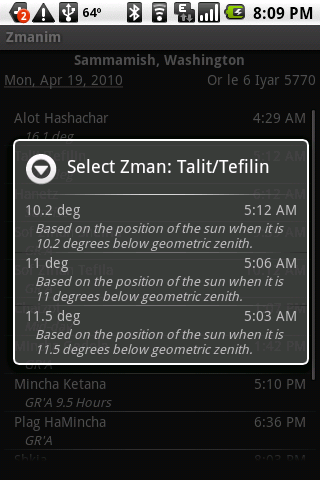
 There are various software projects using the KosherJava Zmanim API. One of the active ones is Jay Gindin’s open source Android Zmanim app for the Android platform. Activity in the project is constant. The upcoming version allows the selection of a specific calculation for zmanim you want such as the zman Talis/Tefilin pictured here. There are plans to add direction to Yerushalayim functionality using the Zmanim API. (For more information on calculating bearing using the API, see Calculating the Bearing/Direction to Har Habayis Using the Zmanim API article.) A large part of Jay’s motivations for developing the code was lezecher nishmas his nephew Shemuel Reuven ben Yehudit Rachel who, lost his battle with cancer on October 21, 2009. The one very minor issue Jay had with the API (and documentation) was the Ashkenazi spelling of the zmanim names, something that as an Ashekenazi I do not plan to change :), but as you can see his Android Zmanim front end used Sephardi labeling. Asked how he found the project, he answered with the typical answer to this question
There are various software projects using the KosherJava Zmanim API. One of the active ones is Jay Gindin’s open source Android Zmanim app for the Android platform. Activity in the project is constant. The upcoming version allows the selection of a specific calculation for zmanim you want such as the zman Talis/Tefilin pictured here. There are plans to add direction to Yerushalayim functionality using the Zmanim API. (For more information on calculating bearing using the API, see Calculating the Bearing/Direction to Har Habayis Using the Zmanim API article.) A large part of Jay’s motivations for developing the code was lezecher nishmas his nephew Shemuel Reuven ben Yehudit Rachel who, lost his battle with cancer on October 21, 2009. The one very minor issue Jay had with the API (and documentation) was the Ashkenazi spelling of the zmanim names, something that as an Ashekenazi I do not plan to change :), but as you can see his Android Zmanim front end used Sephardi labeling. Asked how he found the project, he answered with the typical answer to this question
I Googled around, and found your project.
One of my goals with the API was to make it easy for developers to use and port. This was confirmed by Jay
I found it to be very easy to pull into my app, even on Android…no changes necessary, not even a recompile
 The Zmanim API 1.2 was released today. The only change in this release is the removal of elevation as a factor in the calculation of all zmanim besides sunrise and sunset. Updated
The Zmanim API 1.2 was released today. The only change in this release is the removal of elevation as a factor in the calculation of all zmanim besides sunrise and sunset. Updated  An earlier
An earlier  Moshe Wagner who wrote the
Moshe Wagner who wrote the 